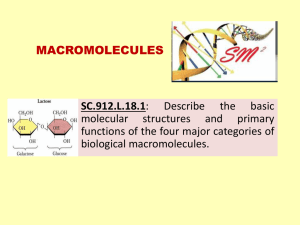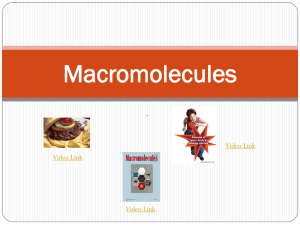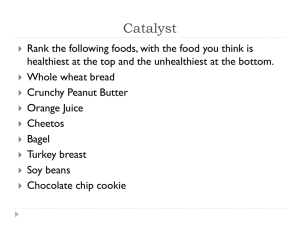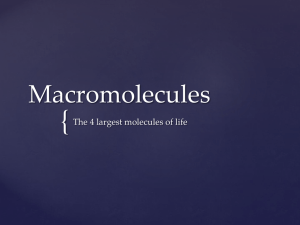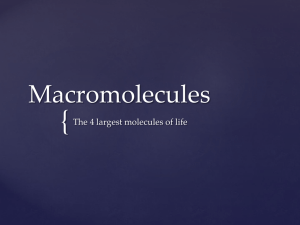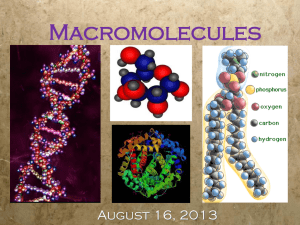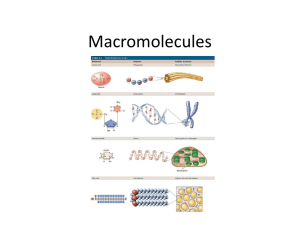Chapter 18: Materials 1: Macromolecules and Self
advertisement
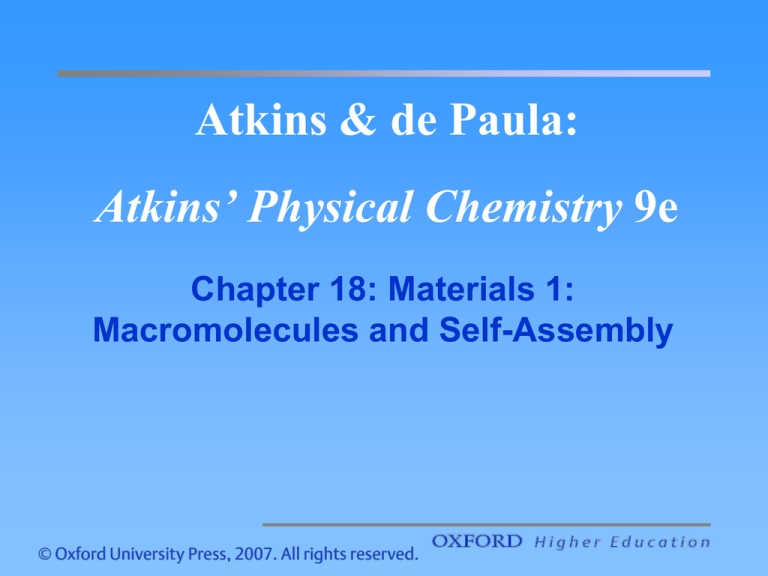
Atkins & de Paula:
Atkins’ Physical Chemistry 9e
Chapter 18: Materials 1:
Macromolecules and Self-Assembly
Chapter 18: Materials 1: Macromolecules and Self-Assembly
polymer, a compound formed by linking together small molecules.
naturally occurring polymers; Proteins, Nucleic acids, Cellulose, Rubber
synthetic polymers; Nylon, Dacron, Lucite
monomer, the small molecules linked together to form a polymer.
Chapter 18: Materials 1: Macromolecules and Self-Assembly
STRUCTURE AND DYNAMICS
configuration, the structural features that can be changed only by breaking chemical
bonds and forming new ones.
conformation, the spatial arrangement of the different parts of a chain.
18.1 The different levels of structure
primary structure, the sequence of small molecular residues making up a polymer.
polypeptide, a macromolecule formed from amino acids .
peptide link, the group –CONH–.
sequencing, the determination of primary structure.
Chapter 18: Materials 1: Macromolecules and Self-Assembly
degradation, a disruption of primary structure.
secondary structure, the (often local) spatial arrangement of a chain.
denaturation, the loss of secondary structure.
tertiary structure, the overall three–dimensional structure of a macromolecule.
quaternary structure, the manner where large molecules are formed by the aggregation
Chapter 18: Materials 1: Macromolecules and Self-Assembly
protein structure; intermolecular forces in a protein molecule.
ionic forces
hydrogen
bonds
dispersion
forces
dispersion
forces
dispersion
forces
ionic forces
dipole-dipole
forces
Chapter 18: Materials 1: Macromolecules and Self-Assembly
18.2 Random coils
random coil, a conformation in which neighboring groups adopt random angles to each
other.
freely jointed chain, the simplest model of a random coil, a conformation in which
any bond is free to make any angle with respect to the preceding one .
Freely jointed chain
Constrained chain
Chapter 18: Materials 1: Macromolecules and Self-Assembly
18.2 (a) Measures of size
probability that ends of a long 1-D freely
jointed chain (N units of length l) are a
distance nl apart (n = NR-NL),
1/ 2
2
2
n / 2 N
P
e
N
(Further information 18.1(a) & Problem 18.20)
probability that ends of a long 3-D freely
jointed chain lie in the range r to r+dr, f(r)dr
3
a 2 a 2r 2
f ( r ) 4 1 / 2 r e
,
a
2
2
Nl
(Further information 18.1(b))
3
1/ 2
Chapter 18: Materials 1: Macromolecules and Self-Assembly
contour length, Rc, the length of a macromolecule measured along its backbone: Rc = Nl.
root mean square separation, Rrms, the square root of the mean value of R2: Rrms = N1/2l.
N 1
R R R
2
r
N 1
rj
i
i, j
N
r
i
N 1
2
r
i
rj
i j
i
N
2
ri Nl
2
i
radius of gyration, Rg, the radius of a thin hollow spherical shell of the same mass and
moment of inertia as the molecule: Rg = (N)1/2l. (Justification 18.1 & Problem 18.16)
N
I
mr
i i
i0
N
2
m ri m tot R
R
2
2
g
m tot ( N 1 ) m
i0
Rg for 3-D random coil: Rg = (N/6)1/2l. (Problem 18.17)
2
g
1
N
r
N 1
i
i0
2
Nl
2
Chapter 18: Materials 1: Macromolecules and Self-Assembly
18.2 (b) Conformational entropy
conformational entropy, the statistical entropy
arising from the arrangement of bonds:
ΔS = –½kNln{(1 + v)1+v(1 – v)1–v}, with v = n/N,
when a coil of N bonds of length l is stretched or
compressed by nl. (Justification 18.2)
18.2 (c) Constrained chains
constrained chains, Rrms & Rg should be multiplied by F= [(1-cosθ)/(1 + cosθ)]1/2
18.2 (d) Partly rigid coils
persistence length, lp; when first monomer-monomer direction is sustained.
lp
R rms
r1
R
1 N 1
l
2l p
1/ 2
N l
1
l
l
r
1
ri
i0
1/ 2
(Further information 18.1(c))
Chapter 18: Materials 1: Macromolecules and Self-Assembly
18.3 The mechanical properties of polymers
elastic deformation, strain is proportional to the stress and is reversible.
plastic deformation, strain is not proportional to the stress.
yield point, turning point from elastic to plastic deformation.
elastomer, a polymer with a long elastic range.
perfect elastomer, an elastomer where the internal energy is independent of the extension.
restoring force of a perfect elastomer extended or compressed by nl is F = (kT/2l) ln {(1 +
v)/(1 – v)} nkT/Nl when v << 1 (with v = n/N). (Justification 18.3)
dU TdS F dx
U
S
T
F
x T
x T
For perfect elastomer,
x nl
F
U
S
0 F T
x T
x T
T S
T S
kT 1 v
ln
l n T
Nl v T
2l 1 v
S 12 kN ln{( 1 v )
1 v
(1 v )
1 v
}, where v n / N
Chapter 18: Materials 1: Macromolecules and Self-Assembly
melting temperature, Tm, the temperature at which
a polymer melts.
glass transition temperature, Tg, the temperature at
which a polymer undergoes a transition from a state
of high chain mobility to one of low chain mobility.
18.4 The electrical properties of polymers
conducting polymer, a polymer with extensive conjugation and thereby conducts electricity.
polaron, a partially localized cation radical in a polymeric solid.
bipolaron, a di-cation version of a polaron.
soliton, two separate cations that move independently in a polymeric solid.
Chapter 18: Materials 1: Macromolecules and Self-Assembly
18.5 The structures of biological macromolecules
18.5(a) Proteins
Corey–Pauling rules, a set of rules that account for the secondary structures of proteins.
1. C, O, N, and H lie in a relatively rigid plane.
2. N, O, and H of a H-bond lie in a straight line.
3. All NH and CO groups are engaged in H-bonding.
restricted rotation
α-helix, a helical conformation formed by hydrogen bonding between peptide links.
β-sheet, a planar conformation formed by hydrogen bonding between peptide links .
Chapter 18: Materials 1: Macromolecules and Self-Assembly
geometry of polypeptide, specified by φ and ψ
Ramachandran plot, a contour diagram of the conformational energy in which one axis
represents φ and the other represents ψ.
nonchiral glycine
Right-handed α-helix (poly-L-glycine)
all φ = 570 and all ψ = -470
chiral L-alanine
Ramachandran plot
Chapter 18: Materials 1: Macromolecules and Self-Assembly
anti-parallel β-sheet, a β-sheet in which φ = –139o, ψ = 113 o, and the N–H–O atoms
of the hydrogen bonds form a straight line; very common in proteins.
parallel β-sheet, a β-sheet in which φ = –119, ψ = 113 and the N–H–O atoms of
the hydrogen bonds are not perfectly aligned.
Chapter 18: Materials 1: Macromolecules and Self-Assembly
The stability of proteins
denaturation, the loss of their natural conformation.
cooperative process, a process which becomes more probable the further it proceeds.
melting temp., Tm, where the fraction of unfolded protein is 0.5.
Chapter 18: Materials 1: Macromolecules and Self-Assembly
18.5 The structures of biological macromolecules
18.5(b) Nucleic acids
polyelectrolyte, a macromolecule with many different charged sites and an overall charge.
base stacking, the organization of the planar π systems of bases by dispersion forces
between them.
Chapter 18: Materials 1: Macromolecules and Self-Assembly
tRNA
Chapter 18: Materials 1: Macromolecules and Self-Assembly
Aggregation & Self-Assembly
Self–assembly, the spontaneous formation of complex structures of molecules or
macromolecules held together by molecular interactions.
18.6 Colloids
18.6(a) Classification and preparation
colloid (disperse phase), a dispersion of small particles of one material in another.
sol, a dispersion of a solid in a liquid or of a solid in a solid.
aerosol, a dispersion of a liquid in a gas .
emulsion, a dispersion of a liquid in another liquid.
lyophilic, solvent attracting.
lyophobic, solvent repelling.
hydrophilic, water attracting.
hydrophobic, water repelling.
gel, a semirigid mass of a lyophilic sol in which all the dispersion medium has penetrated
into the sol particles..
surfactant, a surface–active agent.
electrodialysis, dialysis in the presence of an electric field.
Chapter 18: Materials 1: Macromolecules and Self-Assembly
18.6(c) The electrical double layer
radius of shear, the radius of the sphere that captures a rigid layer of charge around a
colloidal particle.
zeta potential (electrokinetic potential), ζ, the electric potential at the radius of shear
relative to its value in the distant, bulk medium .
electrical double layer, the inner shell of charge and the outer ionic atmosphere around a
colloidal particle.
DVLO theory, a thery of the stability of lyophobic dispersions; balance between repulsive
interaction between the charges of the electrical double layers and the attractive vdW
interactions between the molecules in the particles.
Aa
2
V repulsion
V repulsion
2
e
s / rD
,
R
1
Aa
2
V attraction
B
s
2
ln( 1 e
RT
where rD
2
2 F Ib
s / rD
),
1/ 2
,
when a rD
when rD a
a: particle radius, A & B: constant, R: separation of
centers, s: R-2a, rD: thickness of double layer, I: ionic
strength, ρ: mass density, bΘ: 1 mol kg-1
Chapter 18: Materials 1: Macromolecules and Self-Assembly
flocculation, the reversible aggregation of colloidal particles at high ionic strength.
coagulation, the irreversible aggregation of colloidal particles.
Schultze–Hardy rule: hydrophobic colloids are flocculated most efficiently by ions of
opposite charge type and high charge number.
Chapter 18: Materials 1: Macromolecules and Self-Assembly
18.7 Micelles and biological membranes
18.7(a) Micelles formation
micelle, colloid–sized clusters of molecules.
critical micelle concentration (CMC), the concentration above which micelles form .
Krafft temperature, the temperature above which micelles form.
Chapter 18: Materials 1: Macromolecules and Self-Assembly
surfactant parameter, Ns = V/Al (V: volume of hydrophobic tail, A: area of hydrophilic
head group, l: maximum length of tail)
liposome, a vesicle with an inward pointing inner surface of molecules surrounded by an
outward pointing outer layer.
lyotropic mesomorph, an orderly arrangement of micelles; a liquid crystalline phase.
reverse micelles, form in nonpolar solvent
Chapter 18: Materials 1: Macromolecules and Self-Assembly
Impact on nanotechnology
Self-Assembly of Mesoscopic Metal-Polymer Amphiphiles
S. Park et al., Science 2004, 303, 348.
Chapter 18: Materials 1: Macromolecules and Self-Assembly
18.7(b) Bilayers, vesicles, and membranes
fluid mosaic model, a model of a cell membrane in which the proteins are mobile but have
diffusion coefficients much smaller than those of the lipids.
Chapter 18: Materials 1: Macromolecules and Self-Assembly
18.7(c) Self-assembled monolayers
monolayer, a single layer of molecules on a surface.
Langmuir–Blodgett film, a monolayer that has been transferred to a solid support.
self-assembled monolayer (SAM), an ordered molecular aggregate that form a monolayer
of material on a surface.
Chapter 18: Materials 1: Macromolecules and Self-Assembly
DETERMINATION OF SIZE AND SHAPE
18.8 Mean molar masses
monodisperse, a sample with a single, definite molar mass such as proteins.
polydisperse, a sample with a wide range of molar masses such as synthetic polymers.
number-average molar mass,
1
M
N M M
N
n
i
i
i
viscosity-average molar mass, the average molar mass obtained from viscosity
measurements.
weight-average molar mass, the average molar mass obtained from light-scattering
experiments:
NM
1
M
M
m M M
m
M
NM
2
i
mi N iM i / N A
W
i
i
i
2
i
W
i
i
i
i
Z-average molar mass, the average molar mass obtained from sedimentation
measurements:
NM
3
i
M
Z
i
N iM i
M
3
i
2
M
2
Example 18.1
i
heterogeneity index,
MW
Mn
M
2
M
2
Typical synthetic materials = 4
Monodisperse synthetic polymer < 1.1
commercial polyethene = 30
Chapter 18: Materials 1: Macromolecules and Self-Assembly
18.9 The techniques
18.9(a) Mass spectrometry M n , M W
matrix–assisted laser desorption/ionization (MALDI), a laser-based technique for
ionization of macromolecules.
electrospray ionization, another technique for ionization of macromolecules.
MALDI-TOF mass spectrometry, a technique for the determination of molar masses of
macromolecules that combines MALDI and time-of-flight mass spectrometry.
trans-3-indoleacrylic acid (matrix)
+
NaCl, silver trifluoroacetate
Chapter 18: Materials 1: Macromolecules and Self-Assembly
18.9(b) Laser light scattering M W , R g
Rayleigh scattering, the scattering of light by particles with diameters much smaller than
the wavelength of the incident radiation.
sin
2
I ( , , r ) R ( ) I 0
Rayleigh
ratio , R ( )
I ( , , r )
I0
2 n r
2
R ( ) Kc p M W , K
N A
4
2
r
2
2
sin
2
dn r
dc p
16 R g sin
2
structure
r
factor , P ( ) 1 p ( ) with p ( )
2
3
2
2 1
2
Chapter 18: Materials 1: Macromolecules and Self-Assembly
1
R ( )
1
R ( )
1
R ( )
1
KP ( ) c p M W
1
Kc p M W
1
Kc p M W
1
Kc p M W 1 p ( )
p ( )
R ( )
a
(1 x )
sin
p ( )
Kc p M W
2 1
2
R ( )
p ( )
R ( ) / P ( )
p ( ) P ( )
R ( )
16 R g
2
a
1
3
1
1 x
R ( )
p ( )( 1 p ( ))
R ( )
1
Kc p M W
p ( ) p ( )
2
R ( )
1
p ( )
1
Kc p M W
p ( )
Kc p M W
p ( )
R ( )
2
2
Rg
MW
Example 18.3
Chapter 18: Materials 1: Macromolecules and Self-Assembly
18.9(c) Sedimentation M n , M W
sedimentation, the settling of particles to the foot of a column of solution.
ultracentrifugation, a sedimentation technique in which particles move under the
influence of a centrifugal field.
effective mass , m eff bm , b 1 v s ( : solution density , v s : partial specific volume of solute )
drift speed, a constant speed through a medium when the driving and retarding forces are
balanced.
2
2
s dr / dt , sf m eff r s
2
m eff r
f
bmr
f
( f : frictional coefficien t )
Chapter 18: Materials 1: Macromolecules and Self-Assembly
sedimentation constant
S
s
r
2
bM
n
bM
Stokes ' relation , f 6 a
S
fN A
n
6 a N A
( a : radius , : vis cos ity of solvent )
dr
r S
2
dt
S Mn
ln
r
St
2
r0
Example 18.4
sedimentation equilibria, the equilibrium distribution of particles in a gravitational or
centrifugal field.
MW
2 RT
( r2 r1 ) b
2
2
2
ln
c2
c1
( Justificat ion 18 . 5 )
Chapter 18: Materials 1: Macromolecules and Self-Assembly
18.9(d) Viscosity M V
intrinsic viscosity, the coefficient [η] in η = η0(1+ [η]c + ).
Ostwald viscometer, a device for measuring viscosity from the time taken for a solution to
flow through a capillary and compared with a standard sample..
rotating rheometer, a device for measuring viscosity that consists of rotating concentric
cylinders.
o
t
t0
Ostwald viscometer
0
rotating rheometer
Chapter 18: Materials 1: Macromolecules and Self-Assembly
Mark–Kuhn–Houwink–Sakurada equation for the intrinsic viscosity in terms of the
a
molar mass.
[ ] K M V
[ ] lim (
c 0
0
c 0
) lim (
Example 18.5
[ ] M V
c 0
/ 0 1
c
)
